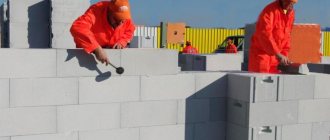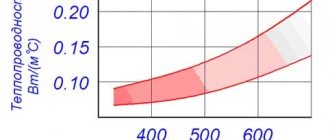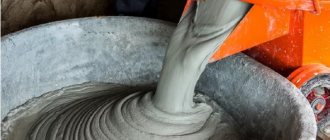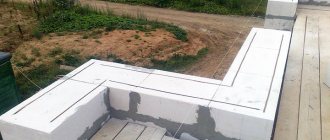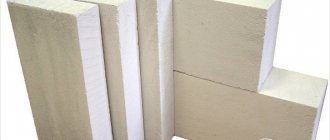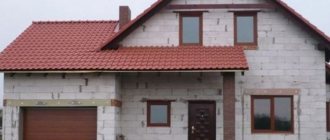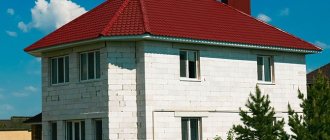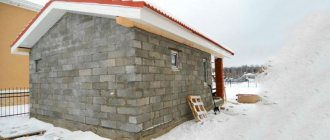Recently, when advertising has become an integral engine of trade, more and more consumers are encountering the other side of the “advertising coin” in different areas of life. In a large number of cases, in pursuit of inviting advantages, people come across existing and not displayed shortcomings.
In the construction industry, advertising also affected the entire product range. New mixtures, insulation and roofing materials, decorative products, etc. are advertised. In the field of materials for the construction of walls, gas silicate blocks are the most advertised material. Let's pay attention to the pros and cons of this material.
What is aerated concrete and gas silicate
Aerated concrete and aerated silicate are types of cellular concrete, that is, building materials that are made on the basis of cement or lime and have a characteristic structure with tiny bubble cells. Such pores are filled with air, which increases the thermal insulation capabilities of the materials.
Theoretically, houses built from cellular concrete do not even need to be insulated, although in the domestic climate additional thermal insulation will still not hurt. To understand the differences between gas silicate and aerated concrete as types of cellular blocks, you must first understand what these materials are.
Aerated concrete and its features
Aerated concrete is a material that is widely used in low-rise construction. It is as warm and reliable a material as traditional brick. But its use allows you to effectively retain heat inside the building.
Advantages of aerated concrete:
- Ideally accurate geometric dimensions. Combined with convenient processing, this allows you to create virtually seamless masonry. The speed of construction work is increasing.
- High thermal insulation characteristics even without an additional insulation system.
- Ecological cleanliness. Sand, cement, water, lime and even aluminum powder do not contain toxic elements and are safe for human health.
- Non-flammability. The use of cellular concrete can improve the fire safety of a building. Even if there is a fire, aerated concrete will not begin to melt.
- Good vapor permeability. Moisture does not accumulate inside, the walls continue to breathe, fungus or mold do not grow in the room, on the contrary, a comfortable microclimate is maintained.
All this makes aerated concrete an excellent choice for construction. Although it also has its drawbacks. This material is not strong enough to be fully used in multi-story construction. Aerated concrete also has not very high soundproofing characteristics compared to traditional brick.
Gas silicate and its features
It is difficult to say unequivocally which is better - gas silicate blocks or aerated concrete, since both materials have their own advantages, which have provided them with a wide range of applications. Gas silicate block is also a type of cellular concrete. Only it contains a lime-siliceous mixture. It contains silicon dioxide, which is why it is called silicate.
Just like aerated concrete, this material lends itself well to various types of processing - drilling, cutting, sawing, so it can be used in private construction, where it is not possible to use complex specialized equipment and lifting equipment (light weight is another advantage of the aerated silicate block).
In fact, it has the same advantages as aerated concrete blocks. But there is still a difference between aerated concrete and gas silicate blocks. It mainly consists of heat and sound insulation properties.
Gas silicate has other disadvantages. This is a hygroscopic material with lower bending strength compared to aerated concrete. The hygroscopicity of gas silicate blocks imposes certain restrictions on their use. In conditions of humidity exceeding 75% they can only be used with additional processing.
Builder tips
The silicate block has weak heat and moisture resistance, so it is recommended to use it not too actively in work. As experienced craftsmen assure, you should not use such material when constructing foundations, cellars, sewer wells and other objects with high levels of humidity.
The initial rows of silicate masonry must be laid above the level at which the height of the snow cover stops so that the rows do not collapse. Before using silicate block material, several rows of ceramics or other building material are used.
If cracks begin to form on the surface of the aerated block wall, then there is no reason to worry. To solve this problem, the surface is puttied with gypsum material. The putty is applied in one layer to hide cracks and all uneven places. After this, a fiberglass canvas of any density is glued to the wall, for which a special adhesive composition is used. As soon as the glue has dried, the canvas is puttied with finishing putty. After this treatment, cracks do not appear in this place for several years, the wall looks excellent and has a good strength indicator.
The main differences between aerated concrete and gas silicate blocks
If you analyze the difference between gas silicate blocks and aerated concrete blocks, you can identify several different characteristics at once. These materials have different indicators of thermal conductivity and frost resistance. They also differ in soundproofing properties. This is explained by the fact that they are produced on the basis of different binders.
Aerated concrete: manufacturing technology
There are gas silicate and aerated concrete blocks, what is the difference in practice - this question interests many. One of the main differences is production technology. Let's consider both options.
Aerated concrete was invented in Sweden in the last century. Today, so-called autoclaved concrete is produced - a material consisting of cement, sand, lime, water and aluminum powder. It is the latter that gives aerated concrete a cellular structure - when it reacts with calcium hydroxide, hydrogen is released and small pores are formed.
The resulting mixture goes through the next stage: vibration. Then it hardens and is cut into blocks with exact dimensions (maximum tolerance - 1-2 mm). These blocks are processed under high pressure in an autoclave. The temperature there reaches 180-200 degrees. This stage is needed in order to increase the strength of the material. The result is a finely porous artificial stone - aerated concrete. For all its strength, it weighs relatively little and can be processed with hand tools. From this point of view, it resembles wood, but at the same time it is fire resistant.
Aerated concrete is not always produced through autoclave processing. There is a variety called air-cured aerated concrete. That is, the process occurs naturally. At the same time, autoclave blocks are distinguished by their white color, while air-hardening blocks are gray. Non-autoclaved aerated concrete is practically not used in modern construction.
Gas silicate: production technology
If you understand how aerated concrete differs from gas silicate, then you need to consider the features of the production technology. At first glance, they are similar. A mixture of quicklime, quartz sand and water is taken, all this goes into the mixer, where aluminum powder is then added. This mixture is distributed into molds and left at a certain temperature for several hours. During this time, the necessary reactions occur, and when the mixture becomes plastic but dense enough, it is divided into blocks and placed in an autoclave under a pressure of 14 bar.
It seems that there are no fundamental differences in this case. The mixture is also processed in an autoclave and gains strength. Aluminum powder is used in the same way to form pores. Then why does the question arise, which is better - gas silicate blocks or aerated concrete blocks, because they should have almost the same properties. The fact is that there is still a difference, and a significant one.
The main difference is in the composition of the mixture. If aerated concrete is produced on the basis of Portland cement, water, sand and lime, then the aerated silicate may not contain cement or it may be added in smaller quantities. Here the binder is a lime-silica mixture.
Manufacturing of gas blocks
The methods for producing aerated concrete and gas silicate are similar. They consist of mixing ingredients, molding and hardening. The only difference is in the binding components.
| Components | Aerated concrete | Gas silicate |
| Sand, water | + | + |
| Lime | + | — |
| Metallic aluminum | — | + |
| Cement | + | + |
The table shows that lime is a gas-forming agent for aerated concrete, and aluminum powder is a gas-forming agent for silicate block.
All components of aerated blocks must be crushed as much as possible. The smaller the particles, the stronger the concrete.
As mentioned above, blocks are autoclaved and non-autoclaved. The goal of the autoclave method is to quickly gain strength and save time for hardening. If we talk about foam concrete, it also saves cement.
It is impossible to visually distinguish blocks from different methods, so it is better to buy material from reputable manufacturers in the construction market.
After autoclave treatment, the monolith is cut with a special string into blocks of the required size. Place on pallets and leave for 28 days to dry completely. After this, the blocks are ready for construction.
Comparative characteristics of aerated concrete and gas silicate
Which is better, gas silicate or aerated concrete blocks, can be decided by comparing their main characteristics. The main differences in the most important operational characteristics are presented in the table.
| Parameter | Aerated concrete | Gas silicate |
| Strength (kg/cm2) | 28-40 | 10-50 |
| Thermal conductivity coefficient (W/mG) | 0,10-0,14 | 0,15-0,3 |
| Volumetric weight (kg/m3) | 400-600 | 200-600 |
| Frost resistance (number of cycles) | 35 | 10 |
| Water absorption (in%) | 20 | 25-30 |
| Soundproofing | average and below | high |
| Durability | More than 70 years | From 50 years and above |
| Vapor permeability coefficient, (µ) mg/m h Pa | 0,2 | 0,17 – 0,25 |
In addition to this, it can be noted that in aerated concrete, due to the use of a different binder, the pores are distributed more evenly, which affects its density, strength and other characteristics.
You can consider these points in more detail to understand how to make the right choice:
- The strength of gas silicate blocks ranges from 10-50 kg/sq.cm, which is explained both by the properties of quartz sand and the uneven distribution of pores. Therefore, the indicators of aerated concrete (28-40 kg/sq.cm) indicate more stable characteristics.
- The thermal insulation properties of aerated concrete are higher, since it has a lower thermal conductivity coefficient. This is also explained by the characteristics of the binder.
- The volumetric weight (density) of both materials varies approximately in the same range. But there is more dense aerated concrete, which is used in monolithic construction.
- In terms of frost resistance, aerated concrete is significantly ahead of its competitor. This makes it the best choice for regions with harsh winters.
- The moisture absorption coefficient of aerated concrete is much lower, which makes it possible in most cases to do without additional processing.
- The sound insulation properties of gas silicate are slightly higher.
- The vapor permeability coefficient of gas silicate varies over a fairly wide range. From this point of view, aerated concrete is a material with a more stable indicator.
- In terms of durability, aerated concrete is superior to gas silicate. This is mainly due to the fact that it has lower moisture absorption and higher frost resistance. However, with additional processing and compliance with the rules of construction and operation, both materials can last quite a long time.
When considering how a gas silicate block differs from an aerated concrete block, one should also note the external data. Aerated concrete with its white surface looks more attractive.
Disadvantages of aerated concrete and gas silicate
These materials also have certain disadvantages. The common feature is low tensile strength, characteristic of all porous materials. However, we can correct this shortcoming. Additional reinforcement of the walls is used and an armored belt is installed on top of the blocks. This allows you to achieve the desired level of strength.
But there are disadvantages inherent only to gas silicate blocks:
- Lower compressive strength compared to aerated concrete. This means that the wall of the house will shrink more during use, and this will lead to the appearance of cracks. This situation is due to the lower density of gas silicate. You can use blocks of a higher volumetric weight than those provided for in the project. But this will lead to increased costs.
- The lower density and smooth surface make it more difficult to choose exterior wall finishes when using gas silicate blocks. This applies not only to plaster, but also to siding.
- The high moisture absorption rates of gas silicate means that it absorbs moisture in large quantities, and in winter this can lead to unpleasant consequences. Additional finishing will protect it from moisture, but construction costs will increase.
- Due to its high moisture absorption, gas silicate cannot be used to construct partitions in a bathroom, indoor pool, etc.
Conclusion
The debate about which expanded clay concrete or gas silicate is better is rather unproductive: each material has its own niche for effective use. But it is still worth noting that, with the exception of some points (moisture absorption, heat resistance), silicate blocks are superior to other porous concrete.
You will receive more detailed information about the technologies and materials used by watching the video in this article (also find out how concrete sockets are installed in the wall).
Features of use in construction
Now that the difference between aerated concrete and gas silicate is clear, it is worth considering how these materials are used in construction. Their use has a lot in common, but there are also differences.
Aerated concrete and its application
Aerated concrete is actively used in private construction. All house structures are built from these blocks, including load-bearing walls and partitions. It is also used in the construction of high-rise buildings erected using monolithic technology. Their frame is made of stronger reinforced concrete. But aerated concrete is used to fill non-load-bearing walls. You just need to choose the right blocks in terms of thickness, density and other parameters.
Even those who have not built themselves know the difference between load-bearing and non-load-bearing walls. They have different loads.
- For load-bearing walls in one- and two-story houses, blocks with a density of 400-500 kg/cub.m. are used.
- In three-story houses or in projects where the load on the walls is higher, material with a density of up to 700 kg/cub.m. is used.
- For partitions, blocks with a density of 300-350 kg/cub.m. are used. In addition, aerated concrete can be used to insulate a building. To do this, take cellular blocks with a density of 100-150 kg/cub.m.
In many regions, when building houses from aerated concrete, it is even possible to do without additional thermal insulation, including when constructing single-layer walls. If we are talking about an area where there are no harsh winters, then for these purposes you can use blocks 30 cm wide. Although many experts believe that it is better to take blocks up to 40 cm wide.
There is one more important point. Aerated concrete, like other porous materials, can absorb moisture. Therefore, before starting construction work, waterproofing should be laid on the foundation. To ensure that the base is sufficiently level, the first row of aerated concrete blocks is laid with a cement-sand mortar, and for subsequent rows a thin layer of glue is used - 2-3 mm is enough. It is applied to the surface of the blocks using a notched trowel. The adhesive solution has higher performance characteristics compared to cement-sand, so its use prevents the appearance of cold bridges.
In the same way, a vertical seam is formed if necessary - if the blocks do not have a tongue-and-groove fastening system. The evenness of the masonry is checked using a building level.
Aerated concrete can be drilled, cut, sawed relatively easily; you do not have to use expensive tools for this. At the same time, this means that laying communications and interior finishing will require less expense.
An important point is the need for reinforcement, which was already mentioned above. In the case of using aerated concrete, it is carried out only if it is provided for in the architectural design. Reinforcement increases the flexural strength of masonry. It becomes resistant to deformation, and this serves to prevent the appearance of cracks in the walls of the house, even if for some reason they appear in the foundation.
Certain parts of the building require reinforcement - for example, window and door openings (special lintels made of reinforced aerated concrete are installed in them), as well as corners, areas under windows, areas where walls rest on ceilings, etc. Depending on the specifics of the project and the selected blocks, reinforcement is made either every fifth row of masonry, or with a smaller step - the fourth.
Gas silicate and its use in construction
When analyzing which is better for construction, aerated concrete or gas silicate, it should be noted:
- Gas silicate blocks rarely have a density higher than 600 kg/cub.m; this limits the scope of its application.
- In private construction, the material is used in the same way as aerated concrete - for load-bearing walls and partitions, they are chosen according to the same principle - for insulation, blocks with a density of up to 200 kg/cub.m, for load-bearing walls - 400-500 kg/cub.m, etc. d.
- When air humidity exceeds 75%, the material undergoes additional processing.
- In private construction, when using gas silicate, a monolithic slab or strip foundation is needed.
- Reinforcing concrete belts are arranged in the same way as in the case of aerated concrete blocks.
Gas silicate finishes should be selected to reduce exposure to moisture. Regular plastering of walls usually does not prevent this. It is recommended to paint with special compounds and only after all internal work has been completed.
Glue or cement?
Laying of gas silicate blocks is done either with a standard cement-sand mortar or with specialized glue. What to choose? First of all, it is worth noting that both fastening substances have a higher thermal conductivity than the gas silicate blocks themselves.
On the cement side the cost is several times lower. The disadvantage is the large thickness of the layer, which increases the width of the cold bridges. The glue allows the blocks to be almost end-to-end, which is very good. However, to lay the first layer of blocks directly on the concrete base, cement mortar will still be needed, since it will allow for the necessary leveling in this case.
